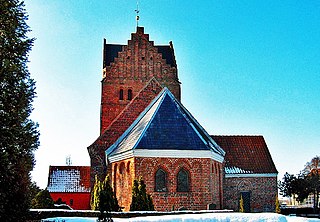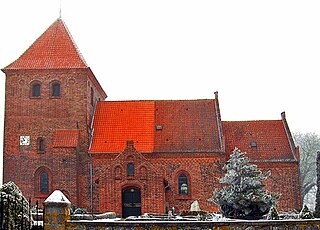
Dannemare Church is a Neo-Romanesque church in the village of Dannemare, some 12 km (7.5 mi) south of Nakskov on the Danish island of Lolland. Built in 1897, it replaced the earlier Romanesque church which burnt down in 1897. [1]

Dannemare Church is a Neo-Romanesque church in the village of Dannemare, some 12 km (7.5 mi) south of Nakskov on the Danish island of Lolland. Built in 1897, it replaced the earlier Romanesque church which burnt down in 1897. [1]
The former Romanesque church from c. 1200 was one of Lolland's oldest brick-built churches. [1] It was owned by the Crown after the Reformation but in 1698 was transferred to the Bådesgård estate which was later owned by Princess Charlotte Amalie. After her death, it was transferred to the State in 1784 until it came into the ownership of local farmers. In 1913, the church gained its independence. [2]
The former building was seriously damaged by a fire on 5 April 1895 which broke out in the rectory west of the church. Large sections of the church were relatively unscathed but, despite ministerial recommendations that the surviving elements should be taken into account in the rebuilding, the old structure was demolished on the grounds that a larger building was needed. The new structure, designed by the architect Aage Langeland-Mathiesen (1868–1933), was completed in 1897. [2]
The former red-brick building had consisted of a Romanesque chancel and nave and a Gothic porch. Today's church consists of a chancel, a nave and a tower whose ground floor serves as a porch. [2] Renovation work was undertaken in 1978. On that occasion, the windows were replaced with stained-glass designs by Mogens Jærgensen. [1]
Several artifacts were saved from the former church and can now be seen in the new building. The altarpiece in the auricular style from the Baroque period was completed around 1640. At the centre, there is a copy of Carl Bloch's painting of Christ's Resurrection. The font from c. 1650 has a hexagonal bowl and is decorated in the Rococo style. In 1976, it was painted blue, representing baptismal water and the joy of baptism. Also of note is the church clock which originally stood in Jægersborg Mansion. It was designed by Poul Petersen in 1771 and restored in 1897 by Bertram Larsen. [1]

Tingsted Church, located on high ground in the village of Tingsted on the Danish island of Falster, dates from c. 1200. Built in the Romanesque style, it is best known for its frescos from the end of the 15th century.

Eskilstrup Church is a church in Eskilstrup, Denmark. The church dates from the 12th century and was built in the Romanesque style. In accordance with a local tradition, it is painted red. It is best known for its frescos, said to be Denmark's oldest.

Freerslev Church is located in the Danish Diocese of Roskilde, Faxe Municipality in Region Sjælland on the island of Zealand. Parts of the original Romanesque church subsist today although there have been substantial Gothic additions. Primitive 14th-century frescos have been uncovered in the arch of an old window on the north wall.

Toreby Church is the parish church of Toreby on the Danish island of Lolland. It is an unusually large red-brick Romanesque building, the nave and chancel having been extended in the Gothic period with a sacristy and lateral aisle. The tower is late Romanesque. There are frescos from c. 1400 in the sacristy. The carved pulpit (1645) is the work of Jørgen Ringnis.

Østofte Church, located in the village of Nørreballe on the Danish island of Lolland, was built in the 14th century. The Romanesque apse, chancel and nave formed the original building while the tower and porch were added in the Late-Gothic period and the north wing was completed in 1656.

Stokkemarke Church is located in the village of Stokkemarke some 11 km (6.8 mi) northwest of Maribo on the Danish island of Lolland. Dating from the middle of the 13th century it was built in the Romanesque style with later additions in the Gothic period.

Hunseby Church is located in the village of Hunseby some 3 km north of Maribo on the Danish island of Lolland. Built in the middle of the 12th century, the church has a Romanesque chancel and nave and a Gothic tower.

Sandby Church is located in the village of Sandby some 7 km northwest of Nakskov on the Danish island of Lolland. Dating from the middle of the 13th century, the church has a Romanesque chancel and nave and a Late Gothic tower.

Errindlev Church is located in the village of Errindlev some 8 km northwest of Rødby on the Danish island of Lolland. Dating from the second half of the 12th century, the church has a Romanesque chancel and nave.

Halsted Church stands in the little village of Halsted some 6 km east of Nakskov on the Danish island of Lolland. Dating from the second half of the 12th century, the church has a Romanesque chancel and nave, a large burial chapel from 1636 and a tower from 1877. The church was closely associated with Halsted Priory, which has not survived.

Nakskov Church is the largest church in Nakskov on the west coast of the Danish island of Lolland. As Nakskov was mentioned in Valdemar's Census Book in the 13th century, the church probably dates to the same period.

Birket Church is located south of the little village of Birket, some 14 km (8.7 mi) northeast of Nakskov on the Danish island of Lolland. Its chancel was originally the nave of the brick Gothic church built in 1350. The bell tower, which stands apart from the church, is believed to be Denmark's oldest standing wooden structure.

Tågerup Church is a Romanesque parish church located 4 km southeast of Rødby on the Danish island of Lolland. Dating from the beginning of the 13th century, its nave is richly decorated with early 16th-century frescos painted by the Brarup workshop.

Fuglse Church is a parish church located some 13 km (8.1 mi) south of Maribo on the Danish island of Lolland. The original Romanesque church was almost totally rebuilt in the Renaissance style in the late 16th century. Standing prominently on a hilltop, the red-plastered building has a tall spire roofed in shingles.

Avnede Church is a Gothic church located some 7 km (4.3 mi) southeast of Nakskov on the Danish island of Lolland. Frescos discovered on the chancel arch during repairs in 2009 are now being restored by the National Museum.

Olstrup Church is a Romanesque church in open country west of Errindlev in the south of the Danish island of Lolland. There are 16th-century frescos of the Last Judgment on the chancel arch with Christ sitting on a rainbow.

Tillitse Church is a Romanesque building west of the village of Dannemare, some 8 km (5.0 mi) south of Nakskov on the Danish island of Lolland. Built of red brick in the first half of the 13th century, it has an intricately carved auricular altarpiece created by Jørgen Ringnis in 1642. An 11th-century runestone stands outside the church entrance.

Arninge Church is a Late Romanesque church in the little village of Arninge, some 8 km (5.0 mi) south of Nakskov on the Danish island of Lolland. Built of red brick in the 13th century, it has an intricately carved auricular altarpiece created by Henrik Werner in 1644.

Gloslunde Church is a Romanesque church east of Dannemare, some 13 km (8.1 mi) southeast of Nakskov on the Danish island of Lolland. Now whitewashed, it was built of red brick in the 13th century.

Stege Church, also Sankt Hans Church, is a 13th-century brick church in Stege on the Danish island of Møn. Now in the Gothic architectural style, the church was originally a Romanesque building.
| Wikimedia Commons has media related to Dannemare Kirke . |